We’re currently experiencing content gold rush. It seems like everyone today is blogging — no matter how mediocre, no matter how un-original the content. Blogging is a great way to prove your authority on a given topic, and everyone is getting on board.
Erica Berger of The Economist says we have reached “Peak Content”, a time of hyper-competition and extreme saturation when it comes to content marketing.
So, what can marketers do to get heard in all this noise? Well, the answer is simple — Differentiate!
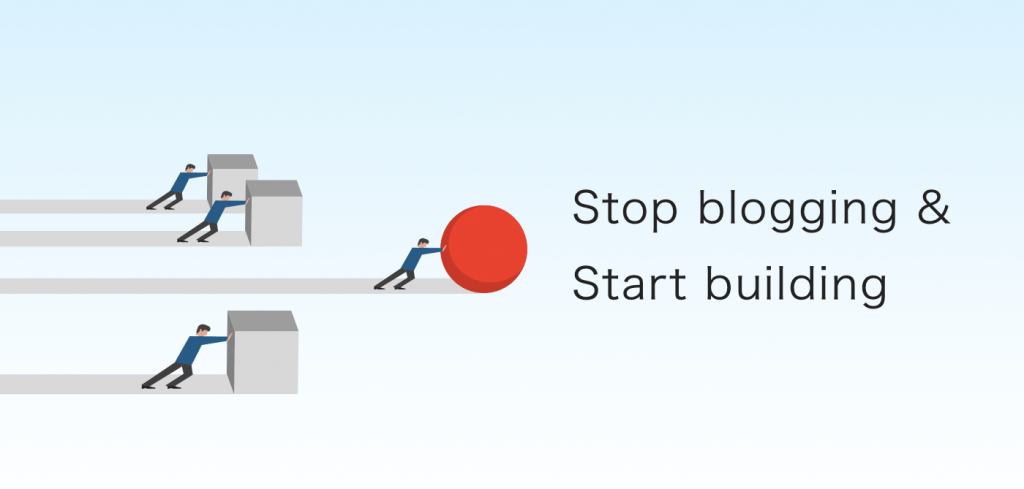
Marketers can differentiate from the competition by focusing on either unique distribution channels (i.e., SEO, smart phones, social media etc) or by creating unique content (i.e., Youtube videos, Snapchat stories, podcasts, eBooks, tools, etc.).
New channels can be meetups, conferences, YouTube, Snapchat, newsletters, podcasts, Instagram stories, bots, messaging apps, etc. Opportunities to differentiate by channel are more abundant than ever (see chart below), and Susan Su previously shared ideas on how marketers can leverage these new channels.
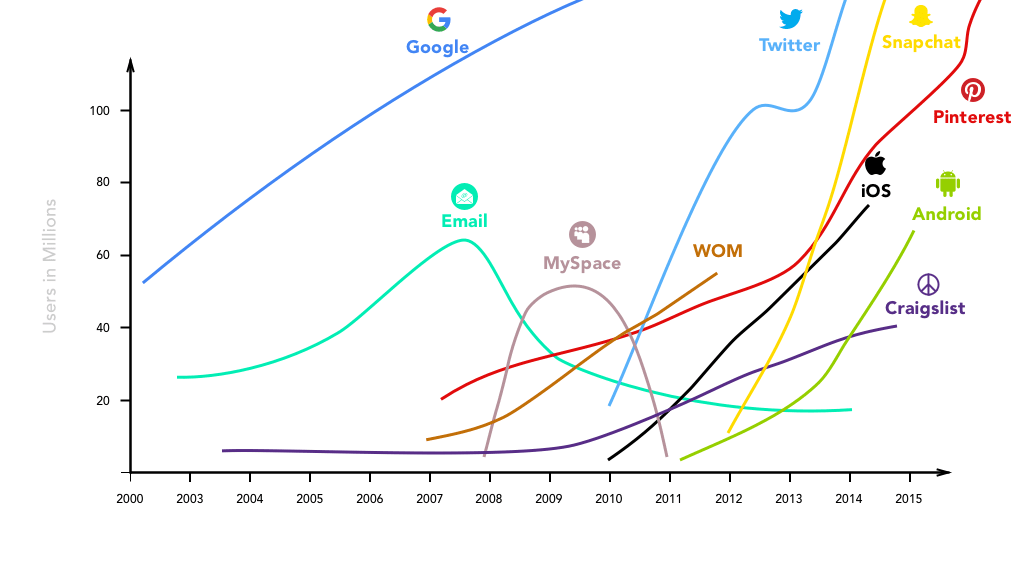
The second way to differentiate in a crowded content marketplace is to create unique and innovative content. This can take many forms — from YouTube videos to podcasts — but the type of unique content I want to focus on in this article is tools. Tools can provide exceptional ROI in terms of traffic, leads, and revenue. Let’s see how.
Tools provide leverage
Hubspot co-founder, Dharmesh Shah, created the first version of Website Grader in three days back in 2006. Website Grader grades your website on things like:
- performance
- SEO
- mobile
- security
For HubSpot, there’s a good chance that people who want to improve their website’s performance are a good fit for its product. Over three million websites have used it and, 10 years after its launch, the tool still accounts for a good portion of HubSpot’s leads.
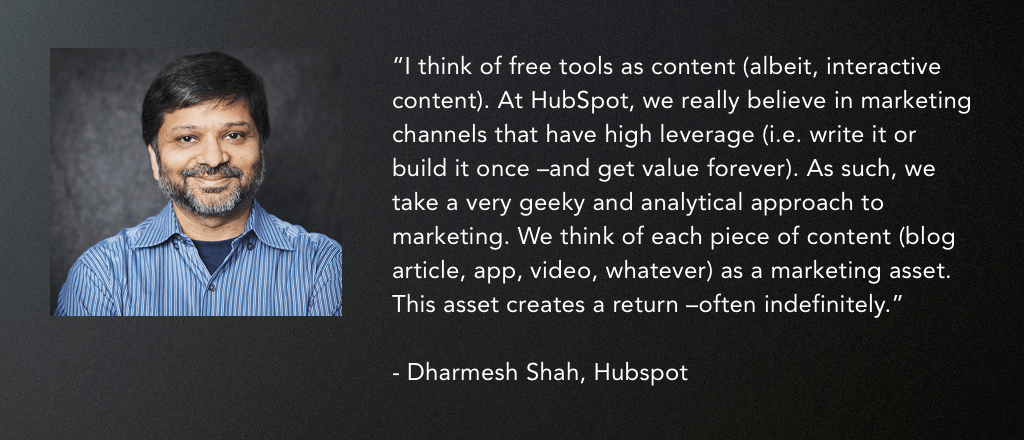
Tools get attention (and press!)
Alex Tew, founder of Calm, a meditation app, has used tools successfully multiple times. When he was preparing to launch his first startup in 2008 — popjam.com, a social network for sharing humorous content — he saw the shoe-hurling incident involving George Bush in the news.
Alex had the idea to build a game around this. Popjam.com was all about sharing funny content so there was a natural fit. His team built a game called, SockandAwe.com — a pun on the US military term ‘shock and awe’, which went immediately viral and got tons of press.

Sockandawe.com got over 10 million views in the first month and captured over 120K emails. When popjam.com launched, this email list was their first audience.
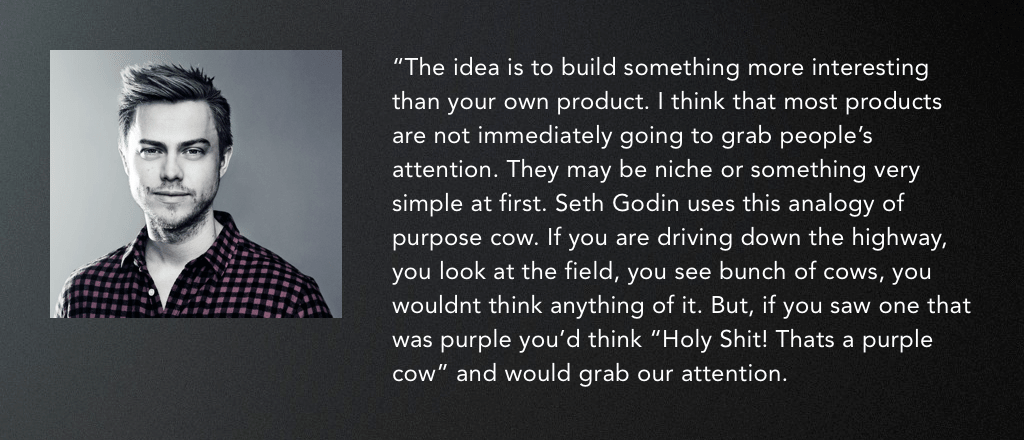
Alex used this strategy again when launching Calm, this time creating an app called Checky. The idea was that people check their phones a lot during the day, Checky let’s them know just how many times by providing a “distraction number.”
Checky went viral, and Stephen Colbert even did a short segment on it!

Users who liked Checky were the exact kind of people who would like an app like Calm. Checky users provided a large portion of Calms 50,000+ early users.
So…how do you know which tools to build?
The right tool for you will ultimately depend on your business, but here are some opportunity areas to look for.
1. Help your customers complete a task easily. These tools are generally a free feature in your product or a separate product that is closely affiliated with your core product. The goal is to help potential customers who are at different stages of their buying journey compete tasks in a relevant domain.
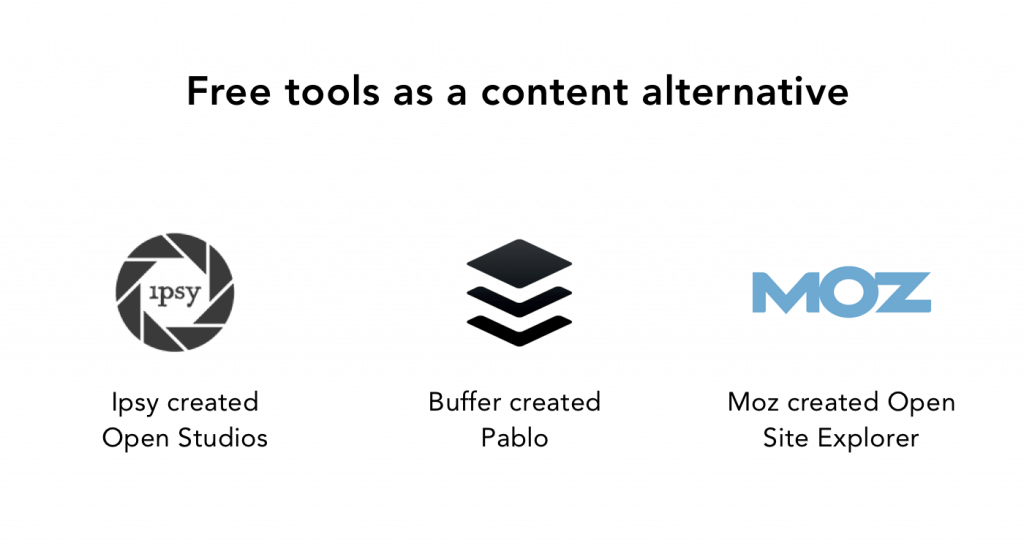
Ipsy created Ipsy Open Studios to help Influencers produce better videos. Ipsy is a personalized cosmetics subscription service from Michelle Phan. From the earliest days Ipsy’s growth has come from influencers driven marketing.
To engage and attract influencers, Ipsy created an in-house creator program Ipsy Open Studios. Open Studios gives influencers access to Ipsy’s top-of-the-line production resources, as well as access mentoring and community building activities.
Buffer built Pablo to help their users create social media friendly images quickly. Buffer discovered that Tweets including images enjoy 150% more retweets than just plain text tweet. That’s why Buffer created Pablo.
Pablo is a free tool that makes it super easy to create social media-friendly images quickly. Since its launch as an MVP, more than 500,000 images have been created, and Buffer has since expanded the product to include more features and cater to other platforms. The first version generated over 1,800 upvotes on Product Hunt, with the second enjoying more than 1,400.
Moz’s Open Site Explorer helped their target audience check backlinks of their website. Moz created Open Site Explorer (or OSE for short). It’s a tool that has generated over 14,000 backlinks and generates over 8,000 visitors each month from organic search alone.
OSE has become part of the overall Moz offering and it used to be the go to tool for many SEO professionals. OSE directly connected to MOZ’ other offerings and proved to be an excellent lead magnet.
2.Build free resources and microsites your users find valuable. Here, the goal is to generate traffic and subscriber base by building an asset that your audience can use repeatedly.
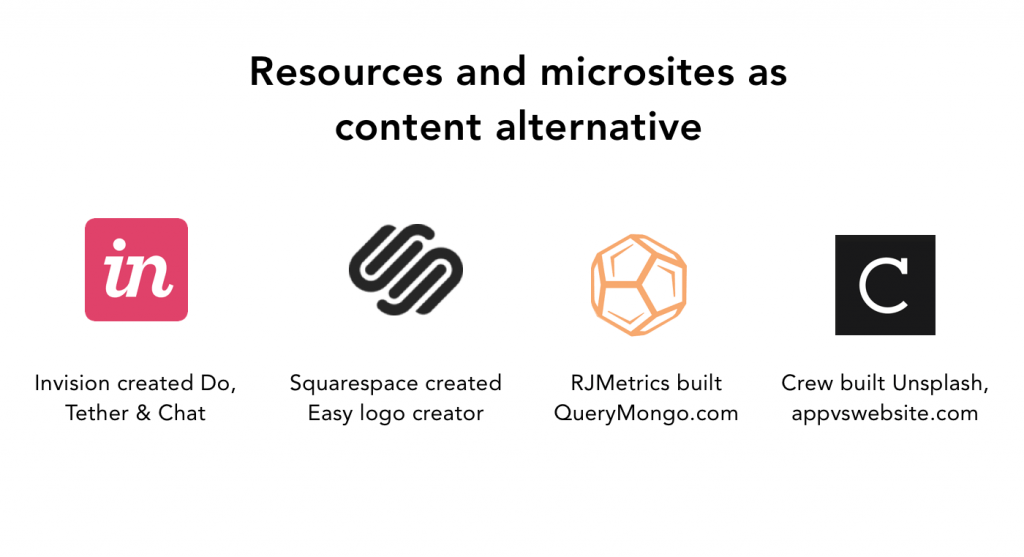
Invision gave away amazing free UI kits and then built a plugin for Sketch to make designers lives easier. InVision, a UI prototyping tool for designers and product makers, fueled their growth by creating free UI Kits for designers. They created gorgeous designs and posted them on designer communities like Dribble and Behance.
Invision took success from these efforts one step further by Labs. One of the first products from Labs is a Sketch plugin called Craft, which has become a critical tool for thousands of designers.
Crew builds helpful microsites and resource to help both freelancers and startups:
- http://appvswebsite.com/
- http://howmuchtomakeanapp.com/
- http://www.gomoodboard.com/
- https://unsplash.com/
Squarespace launched a simple logo creator for their target audience of small businesses or individuals who want to set up a website.
RJMetrics built querymongo.com to help their target audience of developers convert SQL queries to Mongo No SQL queries.
3.Build an online community for your target audience. Here the idea is to create a perpetual audience that you can target any time. It also helps you become a valuable part of audiences life and sets you up as an influencer.
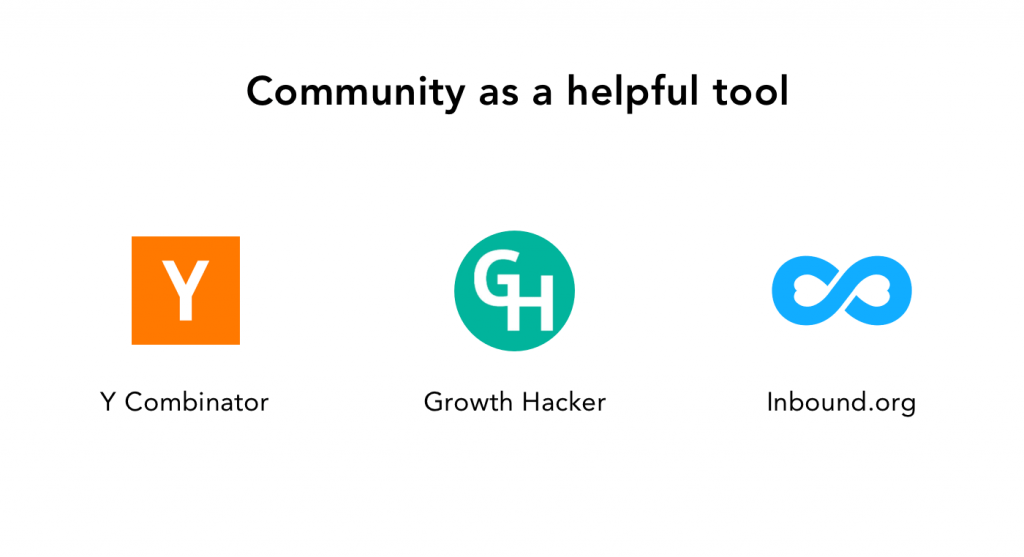
Y Combinator built a community of tech entrepreneurs and enthusiasts called HackerNews. Y Combinator is one of the best and biggest startup incubator programs in the world. They also run and manage a community site called the HackerNews. Here, tech enthusiasts and startup founders participate and learn a lot about tech related and startup related things.
Sean Ellis built Growthhackers.com as a community of marketing professionals. GrowthHackers was one part passion project and one part marketing strategy for Qualaroo, a customer insight and conversion rate optimization tool.
The first version of GrowthHackers leveraged Ellis’ Twitter following of about 10,000 people to begin attracting visitors to the website. Once traffic started coming in, they worked to build a sense of community by reciprocating all visitor interactions.
GrowthHackers has a community of 200,000 members and also provides consulting, training, software, and hiring services
Moz and Hubspot teamed up to build community of inbound marketers called Inbound.org.
You can utilize community building platforms like Reddit, Facebook Groups, Slack, and Spectrum.chat to build a great gathering place for your audience.
Some more startups that successfully leveraged tools, communities, resources and microsites for growth
| Startups | Tools/resources/community they created | What these tools/resources/community do |
|---|---|---|
| WP Engine | WordPress speed tool | Analyze how fast your site loads |
| Attach.io | Pitch deck and sales tools | Help their target audience sell better |
| Bonsai | Freelance rates | Help freelancers discover common hourly freelance rates |
| Splitmetrics | App store optimization checklist | Helps in app store optimization |
| Gigster | Tryblueprint | Helps during initial stage of product development |
| Unenroll | Unenroll.me | Easy way to unsubscribe from spam |
| Ycombinator | Hackernews | Community for tech enthusiasts and startup founders |
| Qualroo | Growthhackers | Online community for growth focused marketers |
| Outreachmama | Link Planning tool | Helps marketers with backlinking |
by Sheetsu.com

How do these builders feel about the success they have found using the tools that they built?
Dharmesh Shah of HubSpot also built a chatbot called Growthbot that helps marketers and sales professionals with on demand information about keywords, monthly visits, top performing content, competition research etc. Here is what Dharmesh said about Growthbot in a recent interview:
“My hope is that not only will the tool be useful to existing HubSpot customers but that it also extends HubSpot’s brand and reach to prospective customers. HubSpot believes strongly in the idea that you should create value for your market before you to try to extract value.
We have reached millions [of users] through our free content, free education and training, and free tools. GrowthBot extends that idea by offering another useful (and free) tool built for our target market. ”
Patrick Whatman, Head of Content at Mention, built Brand Grader, a free online reputation management tool that helps you assess and compare your brand and your competitor’s online performance. Here’s what Patrick said about finding success with free tools:
“We really enjoyed building the Brand Grader, and it generated a lot of business for us in a short period of time.”
Foundersuite is a SaaS startup, a CRM for startups to manage their reports for investors. Building Investor Update helped them become even more helpful to their userbase. Nathan Beckord says this about Investor Update:
“Building useful startup tools has lasting value and can provide returns for many months / years. A really helpful content piece can help bring attention, but unless it’s a comprehensive “how to” guide it’s usually a shorter-lived
These examples have shown that helpful tools can provide companies with a long-term lead generation machine.
Next Steps
To build long lasting lead/brand magnets, you should start with understanding your audience’s needs and pain points. You can do qualitative and quantitative research to get insights from the audience. Once you align their needs with value of your product/service/solution you can start brainstorming ideas on what can be built. I recommend following a typical MVP product development cycle to validate your idea first so that a lot of time isn’t wasted in building something that will not get any traction.
Final consideration, not all companies have focus, time, and resources to go and build something that isn’t part of their core offering — buying existing tools is an option here if budget permits. Sites like feinternational or empireflippers are good places to buy such tools.

Thanks for finally talking about > Stop Blogging and Start Building Tools For Great Content Marketing ROI
– Mobile Patterns < Loved it!
Thanks, Elizbeth. Glad you liked it. 🙂
Great Article. I liked all the examples of tools and microsites you’ve mentioned here.
You’re welcome, Donna. I’m happy this helps. 🙂
Informative blog, I really enjoyed reading it.
Thanks, Cathy. Glad you liked it. 🙂
Great share.
Glad it was helpful. 🙂
My partner and i would like to present thanks to you only for bailing me out and about of this particular difficulties. As a result involving checking throughout the net in addition to meeting techniques that have been not productive, I think our life was done.
You’re welcome, I’m happy this helps. 🙂
As a beginner, hiring people to develop tools is difficult. Is there a way to build small tools with a smaller budget?
I would suggest you try collaborating with other bloggers or developers who are beginning with their journey and see if the cost could be managed/waved-off. Alternatively, you could take some Consulting/Freelancing gigs to earn some money on the side.